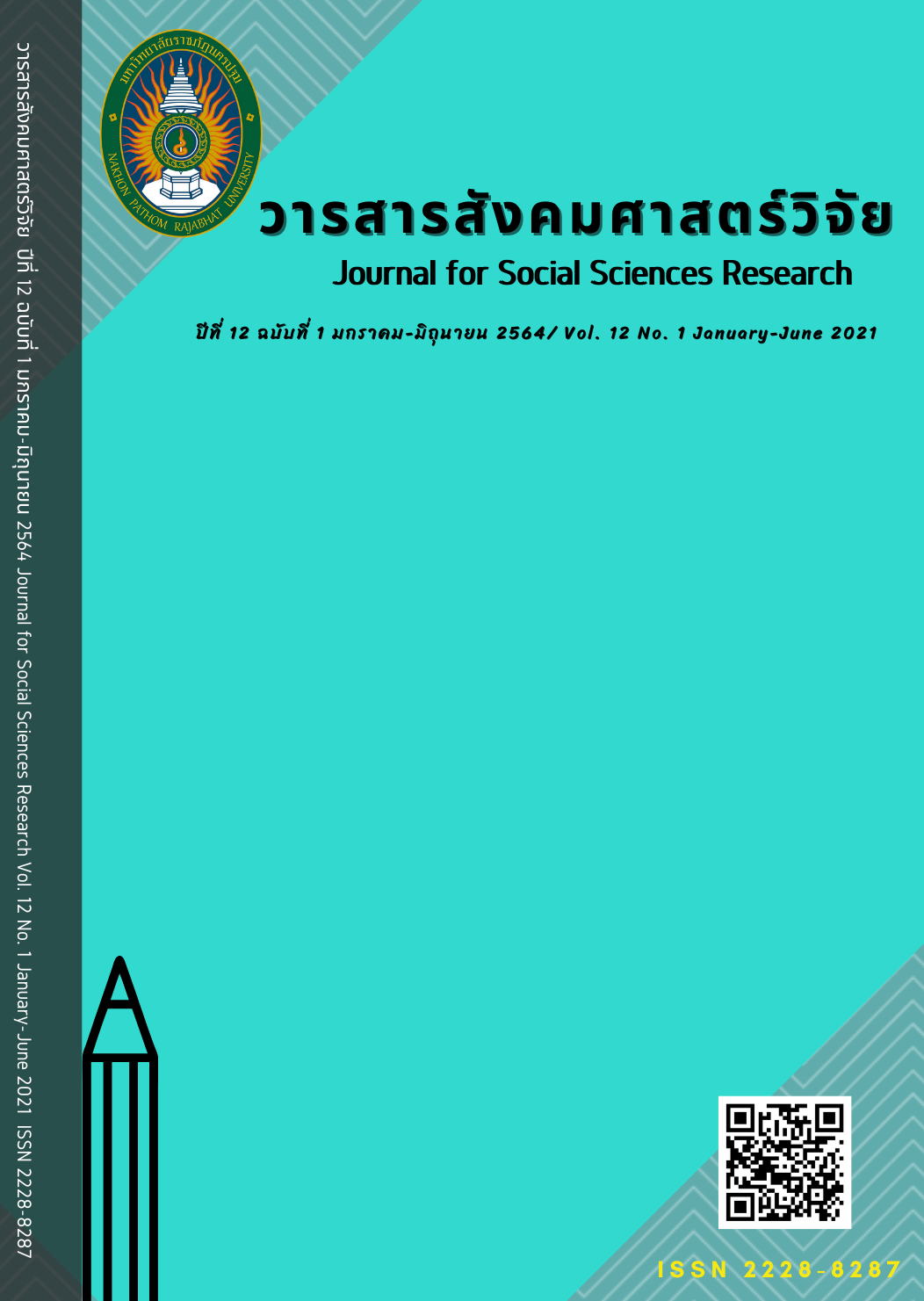THE RELATIONSHIP BETWEEN LANGUAGE AND IDEOLOGY IN ENVIRONMENTAL DISCOURSE PRODUCED BY SEUB NAKHASATHIEN FOUNDATION
Main Article Content
Abstract
This paper aimed to study the relationship between language and ideology in environmental discourse produced by Seub Nakhasathien Foundation. The articles published on Seub Nakhasathien Foundation’s website in the past to 31 December 2018 in total of 464 articles were studied. The linguistic strategies were analyzed based on Fairclough’s critical discourse analysis approach and Van Dijk’s social cognitive analysis approach. Regarding the analysis of discourse practice to understand text production and text consumption, the researcher adopted communicative analysis within the framework of SPEAKING model developed by Dell Hymes.
The findings showed that 5 linguistic strategies were adopted to communicate environmental ideology in the articles published on Seub Nakhasathien Foundation’s website. The strategies used were modality, metaphor, intertextuality, poetry, and rhetorical question. These linguistic strategies reflected the mindset that natural resources and environmental conservation is important and it is the duty of everyone in society to help solve environmental problems. The texts has been reproduced and emphasized so that readers realize the importance of conservation. Additionally, the texts also convince readers to give highly value to natural resources.
Article Details
บทความที่ได้รับการตีพิมพ์เป็นลิขสิทธิ์ของมหาวิทยาลัยราชภัฏนครปฐม
เนื้อหาของแต่ละบทความเป็นทัศนะของผู้เขียน ซึ่งที่ปรึกษา บรรณาธิการ กองบรรณาธิการ และคณะกรรมการบริหารวารสารไม่จำเป็นต้องเห็นด้วย หรือร่วมรับผิดชอบใดๆ
References
จันทิมา อังคพณิชกิจ. (2561). การวิเคราะห์ข้อความ (พิมพ์ครั้งที่ 2). กรุงเทพฯ: สำนักพิมพ์มหาวิทยาลัยธรรมศาสตร์.
จุไรรัตน์ ลักษณะศิริ และอารียา หุตินทะ. (2555). ภาษาไทยเพื่อการสื่อสาร. นครปฐม: โรงพิมพ์มหาวิทยาลัยศิลปากร.
ณัฐพร พานโพธิ์ทอง. (2556). วาทกรรมวิเคราะห์เชิงวิพากษ์ตามแนวภาษาศาสตร์: แนวคิดและการนำมาศึกษาวาทกรรมในภาษาไทย. กรุงเทพฯ: โครงการเผยแพร่ผลงานวิชาการ คณะอักษรศาสตร์ จุฬาลงกรณ์มหาวิทยาลัย.
ธีระ บุษบกแก้ว. (2553). กลวิธีทางภาษากับการนำเสนออัตลักษณ์ของตนเองโดยกลุ่มเกย์ออนไลน์. วิทยานิพนธ์อักษรศาสตรมหาบัณฑิต สาขาวิชาภาษาไทย บัณฑิตวิทยาลัย จุฬาลงกรณ์มหาวิทยาลัย.
พัชริดา พงษปภัสร์. (2560). 30 ปี การคัดค้านเขื่อนน้ำโจน จากความทรงจำของคนในเหตุการณ์. ค้นเมื่อ 21 กันยายน 2563, จาก https://www.seub.or.th/bloging/work/30-ปี-การคัดค้านเขื่อนน้ำ/
มิ่งสรรพ์ ขาวสะอาด. (2553). จุดเปลี่ยนสิ่งแวดล้อมไทย: การวิเคราะห์ช่องว่างนโยบาย (พิมพ์ครั้งที่ 2). เชียงใหม่: สำนักงานกองทุนสนับสนุนการสร้างเสริมสุขภาพ.
มูลนิธิสืบนาคะเสถียร. (2560 ก). การก่อตั้ง. ค้นเมื่อ 22 มกราคม 2563, จาก https://www.seub.or.th/การก่อตั้ง/
มูลนิธิสืบนาคะเสถียร. (2560 ข). ลำดับชีวิต ประวัติ สืบ นาคะเสถียร. ค้นเมื่อ 21 กันยายน 2563, จาก https://www.seub.or.th/seub/biography/story-สืบ-นาคะเสถียร/
รพีพัฒน์ อิงคสิทธิ์. (2561). กอดแม่วงก์: 388 กิโลเมตร จากผืนป่าสู่มหานคร. ค้นเมื่อ 21 กันยายน 2563, จาก https://www.seub.or.th/bloging/work/กอดแม่วงก์-388-กิโลเมตร-จาก/
ลักษณพร ประกอบดี. (2562). NGOs คืออะไร?. ค้นเมื่อ 22 มกราคม 2563, จาก http://thaingo.in.th/news/?p=content&act=detail&id_content=4291
ลัดดาวัลย์ กัณหสุวรรณ. (2541). สิ่งแวดล้อมศึกษา (พิมพ์ครั้งที่ 2). กรุงเทพฯ: ศูนย์วิจัยและฝึกอบรมด้านสิ่งแวดล้อม กรมส่งเสริมคุณภาพสิ่งแวดล้อม.
ศุภณี เรียบเลิศหิรัญ. (2563). เมื่อสังคมออนไลน์มาแทนที่สังคมกระดาษ เราจะอ่านหนังสือกันแบบไหน. ค้นเมื่อ 21 กันยายน 2563, จาก https://thethaiprinter.com/thai/lifestyle_detail.asp?id=695
สืบ นาคะเสถียร. (2560 ก). คำขวัญ-ป่าไม้. ค้นเมื่อ 21 กันยายน 2563, จาก https://www.seub.or.th/seub/ผลงาน/คำขวัญ-ป่าไม้/
สืบ นาคะเสถียร. (2560 ข). เบื้องหลังการทำไม้ที่เขื่อนเชี่ยวหลาน. ค้นเมื่อ 21 กันยายน 2563, จาก https://www.seub.or.th/seub/บทความ/เบื้องหลังการทำไม้ที่เ/
เสกสรรค์ ประเสริฐกุล. (2561). คนกับธรรมชาติ ต้องอยู่ร่วมจึงอยู่รอด (ตอนที่ 1). ค้นเมื่อ 21 กันยายน 2563, จาก https://www.seub.or.th/bloging/work/คนกับธรรมชาติ-ต้องอยู่ร/
Fairclough, N. (1995). Media discourse. London: Arnold.
Fowler, R. (1991). Language in the news: Discourse and ideology in the press. London: Routledge.


